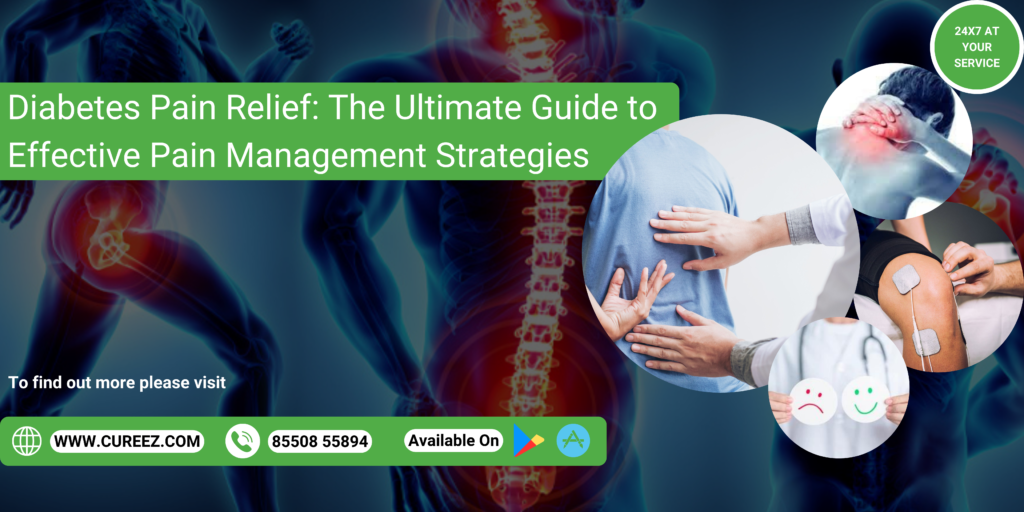Why is there a need for pain management?
Chronic pain is a common and debilitating issue for individuals living with diabetes, significantly impacting their quality of life. From neuropathic pain to musculoskeletal discomfort, the challenges are numerous and often overwhelming. Effective pain management is crucial for optimal diabetes control and overall well-being, allowing individuals to lead more comfortable and fulfilling lives. In this guide, we will explore the various strategies available to manage diabetes-related pain, providing a comprehensive overview of pharmacological and non-pharmacological approaches.
Understanding Diabetes-Related Pain
Diabetes can lead to a variety of pain types, each with distinct characteristics and underlying causes. Understanding these can help in formulating an effective pain management plan.
Neuropathic Pain
Neuropathic pain is caused by nerve damage, a common complication of diabetes, particularly in individuals with poorly controlled blood sugar levels. This type of pain often manifests as burning, tingling, or shooting sensations, typically in the hands and feet. The condition, known as diabetic peripheral neuropathy, can be severe and persistent, significantly affecting mobility and daily activities.
Musculoskeletal Pain
Musculoskeletal pain in diabetes can arise from various sources, including joint problems, muscle aches, and connective tissue disorders. Conditions such as diabetic cheiroarthropathy (limited joint mobility), frozen shoulder, and carpal tunnel syndrome are more prevalent in individuals with diabetes. This pain can limit movement and functionality, further complicating diabetes management.
Pain from Complications
Diabetes can lead to serious complications such as ulcers and amputations, which are often accompanied by intense pain. Poor circulation and neuropathy contribute to the development of these complications, making prevention and proper treatment essential. The pain from these complications can be both physically and emotionally draining, underscoring the need for comprehensive pain management strategies.
Underlying Mechanisms
The pain associated with diabetes arises from various mechanisms:
- Nerve Damage: High blood sugar levels can damage nerves, leading to neuropathic pain.
- Inflammation: Chronic inflammation, a common issue in diabetes, can cause and exacerbate pain.
- Poor Circulation: Vascular issues resulting from diabetes can lead to pain, particularly in the lower extremities, where blood flow is often compromised.
Alternative approaches to diabetes related pain management
Pharmacological Approaches Pain Management Strategies
Pharmacological treatments play a vital role in managing diabetes-related pain. These include a range of prescription medications designed to alleviate different types of pain.
Analgesics
Common pain relievers such as acetaminophen and nonsteroidal anti-inflammatory drugs (NSAIDs) can help manage mild to moderate pain. However, their use should be monitored due to potential side effects, including gastrointestinal issues and kidney damage, especially in long-term use.
Anti-Seizure Drugs
Medications like gabapentin and pregabalin are often prescribed for neuropathic pain. These drugs work by stabilizing nerve activity, reducing pain signals. While effective, they can cause side effects such as dizziness, fatigue, and weight gain.
Antidepressants
Certain antidepressants, particularly tricyclic antidepressants (e.g., amitriptyline) and serotonin-norepinephrine reuptake inhibitors (SNRIs, e.g., duloxetine), are also used to treat neuropathic pain. These medications can help by altering the way the brain processes pain. Side effects may include dry mouth, constipation, and drowsiness, necessitating careful management.
Working with Healthcare Providers
It is crucial to work closely with healthcare providers when using prescription medications for pain management. They can help tailor treatments to individual needs, monitor for side effects, and adjust dosages as necessary. Open communication with healthcare providers ensures a balanced approach to pain relief while minimizing risks.
Non-Pharmacological Pain Management Strategies
In addition to medications, several non-drug interventions can effectively manage diabetes-related pain. These strategies often complement pharmacological treatments, providing a holistic approach to pain management.
Physical Therapy and Exercise Programs
Physical therapy can help alleviate pain and improve mobility through targeted exercises and therapies. Regular physical activity, such as walking, swimming, or cycling, can enhance circulation, reduce inflammation, and strengthen muscles, contributing to overall pain relief. Physical therapists can design personalized exercise programs that cater to individual abilities and limitations.
Cognitive-Behavioral Therapy and Mindfulness Practices
Cognitive-behavioral therapy (CBT) and mindfulness practices can significantly impact pain perception and coping strategies. CBT helps individuals reframe negative thoughts about pain, reducing its psychological impact. Mindfulness practices, including meditation and deep-breathing exercises, promote relaxation and reduce stress, which can exacerbate pain.
Dietary Modifications and Nutritional Supplements
Diet plays a critical role in managing both diabetes and related pain. Anti-inflammatory diets rich in fruits, vegetables, whole grains, and lean proteins can help reduce pain and inflammation. Nutritional supplements such as omega-3 fatty acids, vitamin D, and magnesium may also provide pain relief. Consulting with a dietitian can ensure a balanced and effective dietary approach.
Complementary Therapies
Several complementary therapies have shown promise in managing diabetes-related pain:
- Acupuncture: This traditional Chinese medicine technique involves inserting thin needles into specific points on the body to relieve pain and improve energy flow.
- Massage Therapy: Regular massage can reduce muscle tension, improve circulation, and promote relaxation, helping to alleviate pain.
- Transcutaneous Electrical Nerve Stimulation (TENS): TENS involves using a device to send electrical impulses through the skin, which can help reduce pain by interfering with pain signals.
Why Choose CureEZ?
CureEZ stands out as a leader in comprehensive pain management for individuals with diabetes. Our approach is rooted in a deep understanding of the complexities of diabetes-related pain and a commitment to providing personalized, effective solutions.
Expertise and Experience
Our team of healthcare professionals includes specialists in endocrinology, pain management, physical therapy, and nutrition, ensuring a multidisciplinary approach to pain relief. With years of experience and a dedication to staying at the forefront of medical advancements, CureEZ offers expert care tailored to each patient’s needs.
Personalized Care Plans
At CureEZ, we recognize that every individual’s pain experience is unique. We take the time to understand each patient’s specific pain patterns, lifestyle, and medical history, creating personalized care plans that address their particular needs. Our holistic approach integrates pharmacological treatments, non-drug interventions, and lifestyle modifications for comprehensive pain relief.
Patient-Centered Approach
Our patient-centered philosophy means that we prioritize the comfort, preferences, and overall well-being of our patients. We believe in empowering individuals with the knowledge and tools they need to manage their pain effectively. Through education, support, and compassionate care, we help our patients take control of their pain and improve their quality of life.
Real-Life Examples of CureEZ patients.
Savitha’s Journey to Pain Relief
Savitha, a 55-year-old woman with type 2 diabetes, had been struggling with severe neuropathic pain in her feet for years. Despite trying various medications, she found little relief and her quality of life was diminishing. After seeking help from CureEZ, Savitha underwent a comprehensive evaluation. Our team developed a personalized care plan that included a combination of gabapentin, physical therapy, and dietary modifications. Additionally, Savitha started regular acupuncture sessions and mindfulness practices. Within months, her pain levels decreased significantly, and she regained her mobility and zest for life.
Gangadhar’s Success Story
Gangadhar, a 60-year-old man with a long history of diabetes, suffered from chronic musculoskeletal pain and complications from a foot ulcer. Traditional pain medications provided limited relief, and he faced the prospect of amputation. At CureEZ, we implemented a multifaceted approach to his pain management. Gangadhar’s treatment included antidepressants for pain relief, a tailored exercise program, and nutritional supplements to support healing. Complementary therapies like massage and TENS were also introduced. With this comprehensive plan, Gangadhar’s pain improved, his ulcer healed, and he avoided amputation, allowing him to continue his daily activities with much less discomfort.
Conclusion
Effective pain management is essential for individuals with diabetes to maintain their quality of life and overall well-being. By understanding the different types of pain associated with diabetes and exploring both pharmacological and non-pharmacological strategies, individuals can find relief and improve their daily functioning. CureEZ is committed to providing comprehensive, personalized pain management solutions, helping patients like Savitha and Gangadhar lead healthier, more comfortable lives. If you are struggling with diabetes-related pain, reach out to CureEZ for a tailored approach to pain relief and experience the difference in quality care.

